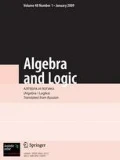We study an extension of temporal logic, a multi-agent logic on models with nontransitive linear time (which is, in a sense, also an extension of interval logic). The proposed relational models admit lacunas in admissibility relations among agents: information accessible for one agent may be inaccessible for others. A logical language uses temporary operators ‘until’ and ‘next’ (for each of the agents), via which we can introduce modal operations ‘possible’ and ‘necessary.’ The main problem under study for the logic introduced is the recognition problem for admissibility of inference rules. Previously, this problem was dealt with for a logic in which transitivity intervals have a fixed uniform length. Here the uniformity of length is not assumed, and the logic is extended by individual temporal operators for different agents. An algorithm is found which decides the admissibility problem in a given logic, i.e., it recognizes admissible inference rules.
Similar content being viewed by others
References
D. M. Gabbay, I. Hodkinson, and M. Reynolds, Temporal Logic, Vol. 1, Mathematical Foundations and Computational Aspects, Oxford Logic Guides, 28, Clarendon Press, Oxford (1994).
D. M. Gabbay and I. M. Hodkinson, “An axiomatization of the temporal logic with until and since over the real numbers,” J. Log. Comput., 1, No. 2, 229-259 (1990).
D. M. Gabbay and I. Hodkinson, “Temporal logic in the context of databases,” in Logic and Reality: Essays on the Legacy of Arthur Prior, B. J. Copeland (Ed.), Clarendon Press, Oxford (1996), pp. 69-87.
M. Wooldridge and A. Lomuscio, “Multi-agent 𝒱SK logic,” Lect. Notes Comput. Sci., 1919, Springer, Berlin (2000), pp. 300-312.
M. Wooldridge, “An automata theoretic approach to multiagent planning,” in Proc. of the First European Workshop on Multi-Agent Systems (EUMAS 2003), Oxford Univ. (2003).
M. Wooldridge, M.-P. Huget, M. Fisher, and S. Parsons, “Model checking for multiagent systems: The MABLE language and its applications,” Int. J. Artif. Intell. Tools, 15, No. 2, 195-226 (2006).
F. Belardinelli and A. Lomuscio, “Interactions between knowledge and time in a first-order logic for multi-agent systems: completeness results,” J. Artif. Intell. Res. (JAIR), 45, 1-45 (2012).
S. Babenyshev and V. Rybakov, “Logic of plausibility for discovery in multi-agent environment deciding algorithms,” in Lect. Notes Comput. Sci., 5179, Springer, Berlin (2008), pp. 210-217.
S. Babenyshev and V. Rybakov, “Decidability of hybrid logic with local common knowledge based on linear temporal logic LTL,” in Lect. Notes Comput. Sci., 5028, Springer, Berlin (2008), pp. 32-41.
S. Babenyshev and V. Rybakov, “Logic of discovery and knowledge: Decision algorithm, in Lect. Notes Comput. Sci., 5178, Springer, Berlin (2008), pp. 711-718.
S. Babenyshev and V. Rybakov, “Describing evolutions of multi-agent systems,” in Lect. Notes Comput. Sci., 5711, Springer, Berlin (2009), pp. 38-45.
V. V. Rybakov, “Linear temporal logic \( {\mathrm{\mathcal{L}}\mathcal{T}\mathrm{\mathcal{L}}}_K \) extended by multi-agent logic Kn with interacting agents,” J. Log. Comput., 19, No. 6, 989-1017 (2009).
R. Fagin, J. Y. Halpern, Y. Moses, and M. Y. Vardi, Reasoning about Knowledge, MIT, Cambridge, MA (1995).
V. F. Yun, “Temporal logic of linear time frames with inductions axiom,” Sib. El. Mat. Izv., 6, 312-325 (2009); http://semr.math.nsc.ru/v6/p312-325.pdf.
J. Hintikka, Knowledge and Belief, An Introduction to the Logic of the Two Notions, prepared by V. F. Hendricks and J. Symons, reprint of the 1962 original, Texts Philos., 1, King’s College, London (2005).
J. F. van Benthem, The Logic of Time. A Model-Theoretic Investigation into the Varieties of Temporal Ontology and Temporal Discourse, Synth. Libr., 156, Reidel, Dordrecht (1983).
M. Y. Vardi, “An automata-theoretic approach to linear temporal logic,” in Workshops in Computing, Springer-Verlag, London (1991), pp. 238-266; http://citeseer.ist.psu.edu/vardi96automatatheoretic.html.
M. Y. Vardi, “Reasoning about the past with two-way automata,” in Lect. Notes Comput. Sci., 1443, Springer, Berlin (1998), pp. 628-641.
L. L. Maksimova and V. F. Yun, “Strong decidability and strong recognizability,” Algebra and Logic, 56, No. 5, 370-385 (2017).
V. V. Rybakov, “Non-transitive linear temporal logic and logical knowledge operations,” J. Log. Comput., 26, No. 3, 945-958 (2016).
V. V. Rybakov, “Nontransitive temporal multiagent logic, information and knowledge, deciding algorithms,” Sib. Math. J., 58, No. 5, 875-886 (2017).
V. V. Rybakov, “Multiagent temporal logics with multivaluations,” Sib. Math. J., 59, No. 4, 710-720 (2018).
V. V. Rybakov, “Linear temporal logic with non-transitive time, algorithms for decidability and verification of admissibility,” in Larisa Maksimova on Implication, Interpolation, and Definability, Outst. Contrib. Log., 15, S. Odintsov (Ed.), Springer, Cham (2018), pp. 219-243.
V. V. Rybakov, “Temporal multi-valued logic with lost worlds in the past,” Sib. El. Mat. Izv., 15, 436-449 (2018); http://semr.math.nsc.ru/v15/p436-449.pdf.
Author information
Authors and Affiliations
Corresponding author
Additional information
Supported by RFBR and by the Krasnoyarsk Regional Science Foundation, project No. 18-41-240005.
Translated from Algebra i Logika, Vol. 59, No. 1, pp. 123-141, January-February, 2020.
Rights and permissions
About this article
Cite this article
Rybakov, V.V. Multi-Agent Temporal Nontransitive Linear Logics and the Admissibility Problem. Algebra Logic 59, 87–100 (2020). https://doi.org/10.1007/s10469-020-09581-0
Received:
Accepted:
Published:
Issue Date:
DOI: https://doi.org/10.1007/s10469-020-09581-0




